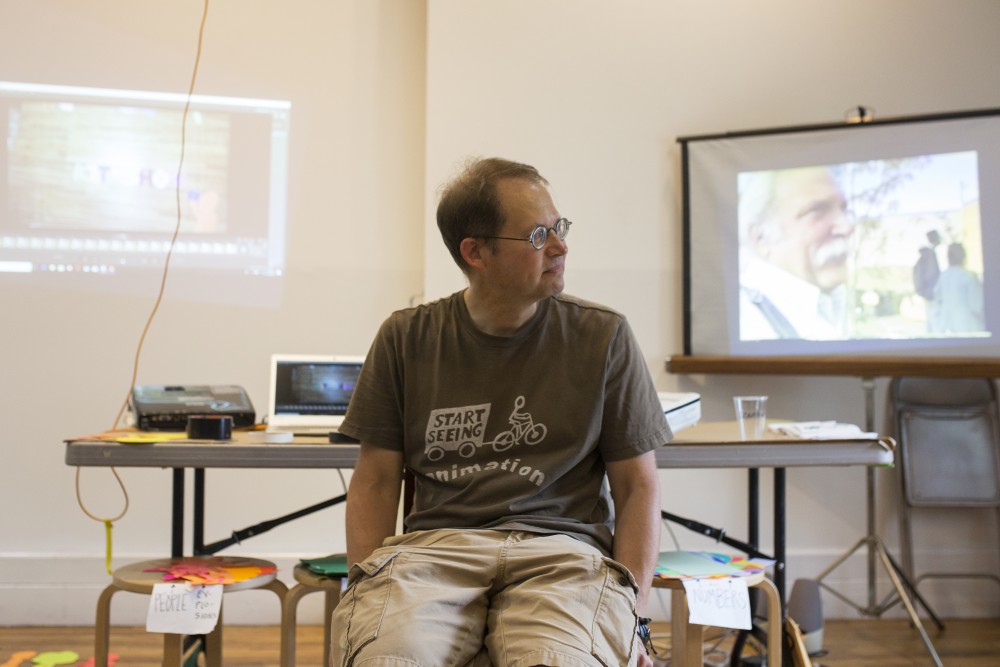At the Susan Hensel Gallery on Saturday, white tape sectioned off a plot on the floor. Inside the rectangle, a strip of black tape represented Lake Street. A green rectangle, with a blue paper lake, stood in for the nearby Powderhorn Park.
The construction of the city on the floor — a depiction of Minneapolis’ Phillips and Powderhorn Park neighborhoods based on how passersby understand them — was filmed to make a stop-motion animation video.
John Akre, the video artist behind this project and Saturday’s Community Media Kit Show, has spent over 25 years living, working and filming in the Phillips and Powderhorn Park neighborhoods. Over the years, he has accumulated hours of footage of community events, from celebrations to parades to protests, which also screened on Saturday.
“[Filming] was my way of discovering the world,” Akre said. “I call it ‘camera courage,’ because when you have a camera and a reason, it’s a way to actually meet people.”
Filmmaker Pam Colby met Akre while working at the Minneapolis Television Network.
“[Akre] goes into communities that sometimes people don’t see … [or] maybe they’re hearing more of the negatives about the place,” she said. “He has always been there portraying the positives [ … ] and seeing the common good.”
Akre’s interest in film began at a young age.
“I’ve been interested in making movies, especially animated films, since I was a little kid,” Akre said. “On my tenth birthday, a neighbor gave me a standard 8mm camera. I basically tried to make my first animated film the next day. Nothing worked out, but I kept working on it.”
The scope of Akre’s work is expansive; his website describes him as an animator, teacher, videomaker, writer and comic creator. He also runs Green Jeans Media, which produces documentaries and animated videos for nonprofit organizations, with his wife, Beth Peloff.
“What strikes me about his animation is, maybe more than anything, just his imagination and his storytelling,” Peloff said. “It feels like he opens this door inside his brain… and these amazing and strange and sometimes just interesting ideas come out.”
Keen on understanding how others use and play with the art form, Akre launched the style of animation used at the gallery on Saturday. He calls it Sloppy Films Animation Station, a large-scale animation studio that — because Akre doesn’t drive — is portable by bus or bike.
“If you actually walk or take transit or ride a bike, you see [the world] very differently. I think you can see it in a much fuller sense than… you do driving through it,” Akre said.
At public events like Art-a-Whirl and Open Streets, Akre shows up with the animation station and a series of prompts, typically focused around how visitors understand and conceptualize their community.

Based on hours of footage, the Community Media Kit Show allowed Akre to share how he understood his community while asking visitors to add their own neighborhood cornerstones and landmarks to the growing, stop-motion animated city on the floor.
“I’ve never done stop-motion video before and I was mesmerized by watching the instant loops that would happen and how the space came alive. A lot of them made me giggle,” said Susan Hensel, owner of the gallery.
The outcome was both personal and expansive, which is exactly how Akre’s collaborators and friends describe his perspective on the world.
“He has a really strong, unique voice that sees the world from [ … ] the ‘John perspective,’” Colby said. “I would say that has always been his strength: seeing community and bringing it together through media.”
Now that the Community Media Kit Show is over, Akre plans to assemble a video that combines his documentary footage, interviews, the neighborhood animation and an original soundtrack by musician and producer Keith Porter, also known as Father Time.
“[John’s work] keeps the true meaning of being an artist in focus. [ … ] Today, people have a lot of things that they can be creative with. I think it’s the tools, not the people, doing the work in most cases” Porter said. “John’s intentions as a human being cut through all of that.”
In Akre’s opinion, community-driven work contrasts the more generalized, global culture that we’re used to consuming.
“To me, culture is something that should be local. Culture is about people interpreting their lives and their place. So, for me, what’s more fulfilling is culture and art about a specific place. [ … ] It contributes to that kind of picture and sound and image of a place, but it also helps people negotiate with their neighbors,” Akre said.
After the first day of construction paper community building, the map on the Susan Hensel Gallery floor had grown. There was a YWCA, the May Day Cafe and a beloved tree that would soon be chopped down.
A community had built its own local, personal microcosm on the floor. Just like Akre had intended.









